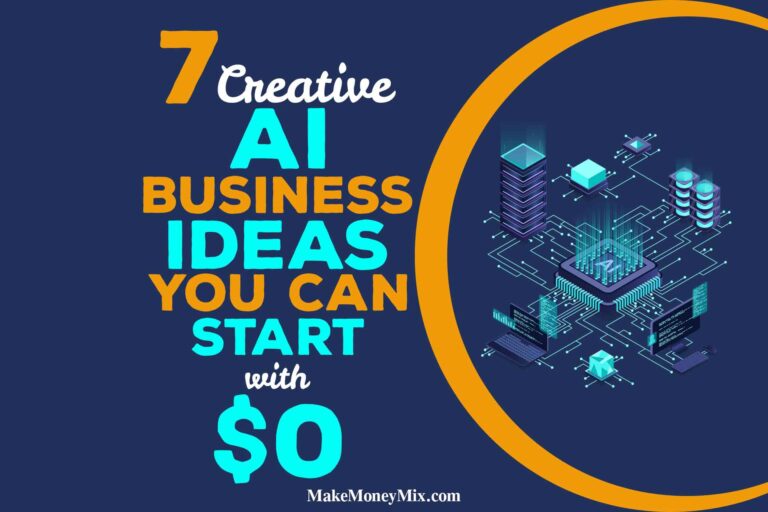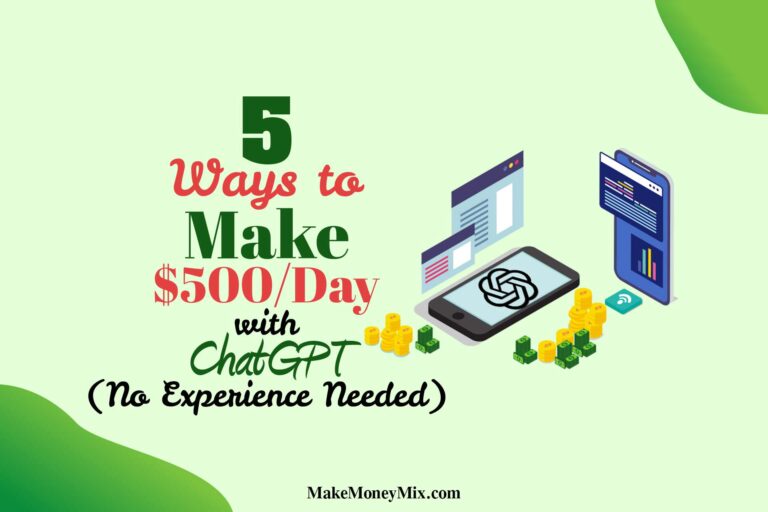9 Hot AI Business Ideas To Consider Right Now

9 Hot AI Business Ideas To Consider Right Now
So, you want to ride the AI wave and actually make money, not just play with shiny tools all day? Same here.
Let’s be real! AI isn’t just a playground for tech nerds or Silicon Valley types anymore.
If you’ve got a bit of hustle and a pinch of creativity, you can turn AI into a legit income stream.
You can even create a full-blown business that works for you while you’re binging Netflix or, I don’t know, finally taking that vacation.
Ready to see what’s hot?
9 Creative AI Business Ideas You Can Start Today
In 2025, AI is no longer just a side hustle; it has become the backbone of modern business strategy.
With 78% of global companies already using AI and 92% planning to increase investment, the landscape is rapidly evolving.
The most successful AI businesses are those that turn technology into real, measurable results, helping companies save time, reduce costs, and unlock new revenue streams without burning out or needing massive teams.
Let’s jump into 9 AI business ideas that are blowing up right now, with my own take on why they’re worth your time.
1. AI Content Repurposing Studio: One Idea, Infinite Reach
Ever feel like you’re working way too hard for way too little content reach? You’re not alone.
Most people don’t have a content problem; they have a distribution problem.
They post once, maybe twice, and then move on, leaving 90% of their content’s value on the table.
What if you could turn one video into a dozen pieces of content, all before your coffee gets cold?
Welcome to the world of AI-powered content repurposing studios.
What Is an AI Content Repurposing Studio?
Imagine this: You take a long-form video (like a webinar or podcast), and with a few clicks, AI slices it into:
- 10 short video clips for TikTok, Reels, or YouTube Shorts
- 5 tweet/X threads
- 3 Instagram carousels
- 1 blog post
- 1 email sequence
All of this happens automatically, thanks to smart AI tools.
Why This Business Is Blowing Up:
- By 2025, 30% of all marketing content is expected to be AI-generated, with repurposing as one of the fastest-growing use cases.
- Major brands, such as Nike and DoorDash, already utilize AI to enhance their content output and dominate various platforms.
- Creators, coaches, and educators are in desperate need of help. Nobody wants to edit 20 versions of the same video.
How to Build and Monetize Your Repurposing Studio:
1. Choose Your Tools
- Utilize Opus Clip, Descript, SendShort, Lumen5, InVideo, and Kaltura to transform long-form content into concise clips, social posts, and more.
- Utilize ChatGPT, Claude, or other large language models (LLMs) to generate tweet threads, blog posts, and email copies from transcripts.
- Use Storyblocks and Canva to add premium visuals, motion graphics, and B-roll footage to make your content look professional (and charge more for it).
2. Build a Workflow
- Start with high-value, evergreen content —content that’s always relevant and already performs well.
- Utilize AI to analyze performance and identify the most effective moments for repurposing.
- Automate the transformation: transcribe, clip, summarize, and create new formats.
3. Offer Killer Packages
- Monthly Repurposing Services: Charge clients a flat fee to turn their weekly videos into dozens of assets.
- Niche Content Kits: Package AI-enhanced content bundles for specific industries (e.g., fitness, finance, education).
- Premium Polish: Use stock media and human editing to add emotional resonance—AI handles the logic; you deliver the feeling.
4. Scale Up
- Build a portfolio of happy clients who never want to touch editing again.
- Use case studies and testimonials to attract more business. Every successful project is proof you’re the go-to expert.
Tips for Success
- Don’t Just Automate—Elevate: AI can churn out content, but you add the emotional resonance. Utilize stock footage, custom graphics, and sound design to make it stand out.
- Focus on Results: Clients care about reach and engagement, not just volume. Show them the numbers.
- Stay Organized: Utilize project management tools to track deliverables and keep clients informed.
Why This Works:
AI-powered content repurposing is the ultimate leverage play.
You help clients get 10x the value from every idea, and you build a business that scales without burning yourself out. Additionally, you get to work with cutting-edge technology all day. What’s not to love?
2. AI Spokesperson Videos: Your Brand, Always On
Let’s be honest: nobody wants to wrangle actors, book a studio, or spend hours editing just to get a 30-second “welcome” video for their business.
That’s why AI spokesperson videos are blowing up right now.
If you’ve ever wished you could clone yourself (or your most charismatic team member) to be everywhere at once, this is as close as it gets, minus the sci-fi weirdness.
What’s the Big Deal with AI Spokesperson Videos?
Think about how businesses used to do it:
- 2010: Hire a brand ambassador (expensive, unreliable schedules).
- 2015–2020: Rely on user-generated content and testimonials (great, but inconsistent).
- Now: Utilize AI-generated video hosts with synthetic presenters who deliver your message with zero drama and 100% consistency, 24/7, in any language you require.
These avatars are no longer clunky or robotic. They look and sound shockingly real.
You can have a digital “you” (or a custom avatar) explain products, onboard new hires, or greet website visitors with no coffee breaks required.
How Does It Work?
- Pick a tool: Popular options include Synthesia, HeyGen, Elai, and Tavus.
- Choose an avatar: Go with a stock presenter or create a custom one that matches your look and voice.
- Write your script: Type in what you want your spokesperson to say.
- Customize: Add your branding, background music, and visuals to make it truly stand out.
- Generate and share: Download, embed, or stream your finished video anywhere you want.
You don’t need video editing skills or fancy gear, just your ideas and a few clicks.
Why do Businesses Love This?
- Scalable: Make one video or a hundred in minutes, not weeks.
- Multilingual: Speak to global audiences in 140+ languages—no need to hire translators or voice actors.
- Always on-brand: Your avatar never has a bad hair day or forgets the script.
- Cost-effective: No more paying actors, renting studios, or waiting for edits.
Who’s Using This?
- Real estate agents: 24/7 explainer videos for listings.
- Coaches: Personalized welcome videos on every funnel page.
- SaaS founders: Onboarding tutorials and support videos without being on camera.
- E-commerce: Product demos and customer support instantly.
Pro Tips
- Personalize: Use custom avatars for a unique, branded experience.
- Add emotion: Pair AI logic with human touches, such as cinematic B-roll, music, and motion graphics, to build trust and engagement.
- Charge monthly: Offer ongoing updates and new videos as a subscription service.
In short, AI spokesperson videos are the new face of modern business, offering a friendly, scalable, and always-ready platform to deliver your message.
Why not let your digital twin do the talking while you focus on the big stuff?
3. AI Business Validation & Launch Kits: From Idea to Action
Have you ever had a “million-dollar idea” that fizzled out before it was launched? (Yeah, me too.)
Here’s the secret: It’s not the idea that matters; it’s how fast and smart you validate and launch it.
That’s where AI-powered business validation and launch kits come in.
They’re like having a startup mentor, market analyst, and branding agency in your pocket—all powered by AI.
Why Business Validation Matters?
Let’s get real:
- Everyone has ideas.
- Winners validate quickly, clarify their value, and launch before their competitors do.
Old-school validation is slow, expensive, and fraught with uncertainty.
AI changes the game by automating research, analyzing trends, and even helping you craft your first offer.
So, you can move from “maybe” to “money-maker” in record time.
What’s in an AI Business Validation & Launch Kit?
- Market research: AI tools scan industry reports, online data, and competitor activity to spot real opportunities (no more wild guessing).
- SWOT analysis: Instantly generate strengths, weaknesses, opportunities, and threats for your idea so you know what you’re up against.
- Positioning and branding: Get AI-generated names, slogans, and positioning statements tailored to your target market.
- Go-to-market strategy: AI helps map out how you’ll reach customers, which channels to use, and how to differentiate yourself.
- Landing pages and mockups: Tools like Midjourney or Ideogram enable the creation of visuals and brand assets in minutes, eliminating the need for a designer.
- Outreach templates: AI drafts your first emails and social posts to test the waters and attract early users.
- Validation reports: Receive a comprehensive analysis (including market size, competition, and pricing) to pitch investors or partners confidently.
How Do You Sell This?
- Package it as a service: Offer validation kits to new founders, agencies, or anyone with a business itch.
- DIY or done-for-you: Some clients want the tools; others want you to run the process. Either way, you’re selling clarity and certainly not just branding.
- Recurring income: Offer monthly validation checks or launch support as a subscription.
Real-World Example
Platforms like DimeADozen.ai and the SaaS Validation Kit have already helped tens of thousands of entrepreneurs test their ideas, analyze competitors, and become market-ready in days, not months.
One founder said it best: “Saved me tons of time and money. Now, I feel like a software generation machine.”
Pro Tips
- Focus on outcomes: Don’t just deliver a pile of data; give actionable insights and clear next steps.
- Stay current: Use AI tools that pull real-time data for the most accurate validation.
- Add your touch: AI does heavy lifting, but your experience and judgment make the results truly valuable.
4. AI Automation Consulting: Be the Systems Thinker
Have you ever looked at a business drowning in spreadsheets, sticky notes, and endless email threads and thought, “There’s gotta be a better way”?
Well, you’re right, and that “better way” is AI automation consulting.
This isn’t just about plugging in a chatbot or tossing out a few Zapier automations.
It’s about transforming chaos into streamlined, money-saving systems.
And trust me, businesses are desperate for this kind of help.
Why Is AI Automation Consulting So Hot?
The market is massive: AI automation consulting is already a $72.5 billion industry, with top consultants charging thousands per project or even monthly retainers.
Every business wants efficiency: Small businesses, agencies, and even legacy companies are realizing they don’t need more people; they need more intelligent systems.
It’s all about outcomes: Clients don’t care about the tech jargon. They want results like more time, less manual work, and fewer headaches.
What Does an AI Automation Consultant Do?
- Map out business processes: You walk in, observe how things are done, and identify the bottlenecks.
- Identify automation opportunities: Maybe it’s lead qualification, client onboarding, content repurposing, customer service, or internal reporting; there’s always something to optimize.
- Build the bridge: You connect what’s done manually to what AI can handle on autopilot, using tools like Zapier, Make, Airtable, Notion, and GPT-powered agents.
- Deliver ongoing value: Offer one-time setups or, even better, monthly retainers for continuous optimization. Businesses love having you on call for tweaks and upgrades.
How Do You Make Money?
- Project fees: Design and implement automation for a flat rate.
- Retainers: Offer ongoing support and optimization—think of it as being the business’s “AI systems coach.”
- Niche solutions: Once you build a killer workflow for one industry, you can sell it to dozens more. The real money is in multiplying your success, not reinventing the wheel every time.
Real Talk: Why This Works
I’ve seen clients go from chaos to calm after just a few weeks of automation.
When you save someone hours every week, you’re not just a consultant; you’re a hero.
And the best part?
You get to play with the latest tech, solve real problems, and build a business that scales without burning yourself out.
Pro Tip: Don’t just focus on the tools. Focus on outcomes.
Businesses want someone who can turn AI into real, measurable results, not just another app they’ll forget about in a month.
5. AI Engineering (No-Code, Low-Code, Full-Code): Build Solutions, Not Just Models
Let’s bust a myth!
You don’t need to be a coding wizard to cash in on AI engineering.
Sure, if you know Python, that’s awesome.
However, with today’s no-code and low-code platforms, anyone with a bit of technical savvy and business sense can build robust AI solutions that people will pay for—big time.
What Is AI Engineering in 2025?
It’s about building solutions: The world doesn’t need more AI models—it needs practical, business-ready systems that solve real problems.
No-code and low-code are booming: Platforms like Replit, Bubble, and others let you build apps, dashboards, and automation without writing a single line of code.
Demand is skyrocketing: The AI engineering market is growing at a rate of over 37% per year and is expected to reach $84 billion by 2029.
What Can You Specialize In?
- AI-powered dashboards: Use Python or low-code tools to create dashboards that turn raw data into actionable insights.
- LLM integrations: Connect large language models (like GPT-4 or Claude) to business logic using frameworks like LangChain or LlamaIndex.
- Custom automation: Build apps that automate everything from customer support to internal reporting using drag-and-drop interfaces.
- Industry-specific tools: Think healthcare analytics, real estate lead trackers, or e-commerce recommendation engines.
How Do You Monetize Your Skills?
1. Freelance gigs: Offer your services on Upwork, Fiverr, or directly to businesses needing custom AI solutions.
2. Consulting: Partner with startups or established companies to design and implement AI-powered systems.
3. Productize: Build a tool once, license it to multiple clients, and enjoy recurring revenue—hello, SaaS dreams!
4. No-code/low-code development: Help non-technical clients bring their ideas to life quickly and affordably.
Why Is This a Game-Changer?
- Low barrier to entry: You don’t need a PhD or a huge dev team. With no-code tools, you can go from idea to prototype in days, not months.
- Scalable income: Build once, sell many times. Or offer ongoing support and upgrades for a steady stream of income.
- Real impact: Businesses are eager for solutions that save time, reduce costs, and increase profits. If you can deliver that, you’ll never be short on clients.
AI engineering is the ultimate combo of creativity and tech.
Whether you’re a code geek or a business brain, you can carve out a niche, build something valuable, and get paid well for it.
6. Prompt Coaching for SMBs: Be the Translator
Have you ever watched someone try to use ChatGPT and end up with a response that’s, well, a total dud?
Yeah, me too.
Most small businesses don’t need a full-blown AI engineer.
They need someone who can translate their messy, real-world tasks into clear, effective prompts that get results.
That’s where prompt coaching comes in, and trust me, it’s one of the hottest gigs around.
What Does a Prompt Coach Actually Do?
You’re the bridge between humans and AI. Instead of letting teams flounder, you:
- Sit down with marketing, sales, or operations teams and demonstrate how to optimize their use of ChatGPT, Claude, or any other large language model (LLM) they employ.
- Turn vague requests (“Can you help with our social media?”) into structured, repeatable prompt systems.
- Tailor prompts to each business’s tools, workflow, and brand voice.
- Create prompt libraries and custom GPTs for specific business needs.
- Host onboarding workshops so teams stop Googling “best ChatGPT prompt” and start working smarter.
Why Is This So Valuable Right Now?
Let’s be real: “Garbage in, garbage out” is the law of AI.
Most people get poor results because they don’t know what to ask.
As a prompt coach, you fix that, and businesses love you for it.
I’ve seen coaches charge anywhere from $30 to $100+ per hour, and every happy client becomes your best marketing asset.
How Do You Make Money?
- One-on-one sessions: Help founders or team leaders get instant wins.
- Prompt packs: Sell bundles of high-performing prompts tailored to specific industries or tasks, such as real estate listings, social media, HR, and sales outreach.
- Workshops: Run group training sessions in live or async tailored to each team’s workflow.
- Custom GPTs: Build branded AI assistants with pre-loaded instructions for repetitive tasks.
Real Talk: What Makes a Great Prompt Coach?
You don’t need to code or have a considerable following. You just need to:
- Know how to talk to people and AI.
- Be a problem-solver who loves turning chaos into order.
- Stay ahead of the curve with new AI features and tools, ensuring you’re always a step ahead.
7. AI Consulting & Training Firms: Bridge the Knowledge Gap
Most companies recognize the importance of AI, but their teams are often stuck Googling tools, writing weak prompts, and wasting hours trying to figure it out.
Enter the AI consulting and training firm into the scene.
It is your chance to become the “AI sensei” every business desperately needs.
What Do AI Consulting & Training Firms Actually Do?
Audit business processes: Walk in, assess what’s working (and what’s not), and spot where AI can save time, cut costs, or boost revenue.
Develop AI strategies: Create a roadmap for leveraging AI across the company, from marketing to operations.
Train teams: Run live or asynchronous workshops so that teams can actually use the tools, not just discuss them.
Create templates and frameworks: Package your expertise into reusable resources such as prompt libraries, workflow guides, and onboarding checklists.
Why Is This Business Model So Hot?
- 92% of companies plan to increase their AI investment, but only 1% feel confident about its implementation. That’s a massive gap, and it’s your golden opportunity.
- Consultants and trainers charge hundreds to thousands per session because the ROI is so obvious: increased productivity, reduced wasted time, and happier teams.
- You don’t need to be a “genius”; just know more than your clients and be able to explain it clearly. (And if you love teaching or coaching, this is your playground.)
How Do You Get Started?
Build your expertise: Take online courses, experiment with tools, and stay up-to-date on AI trends.
Offer pro bono training: Get testimonials and case studies by helping a few businesses for free at first.
Network like crazy: Attend industry events webinars and join online communities. Most consulting gigs come from relationships, not cold emails.
Package your offer: Create clear service tiers (e.g., one-time audit, ongoing training, custom workshops) and price them based on the value delivered.
What Services Can You Offer?
- AI strategy development: Help businesses determine where AI fits into their overall strategy.
- Implementation support: Guide companies through integrating AI tools into their existing workflows.
- Team training: Teach practical, hands-on skills so employees can utilize AI effectively in their day-to-day work.
- Ongoing optimization: Offer retainer packages for regular check-ins and updates as AI continues to evolve.
Why Does This Work?
You’re not just selling knowledge; you’re selling clarity and confidence.
Companies want to stop spinning their wheels and start seeing results.
If you can bridge the gap between curiosity and capability, you’ll always be in demand.
Pro tip: Focus on outcomes, not just theory. Show real-world wins, like how you helped a sales team automate outreach or taught a marketing team to generate better content in half the time.
8. AI Automation Agency: Sell Results on Autopilot
Ever feel like small businesses are drowning in a sea of repetitive tasks, such as bookings, invoices, social media posts, and follow-ups, to name a few?
Most of them don’t need a full-time COO (and, let’s be real, can’t afford one).
What they do need is automation.
That’s where the AI automation agency comes in, and trust me, this is one of the hottest, most scalable AI business models out there.
What Does an AI Automation Agency Do?
You’re the “systems superhero” for businesses. Here’s how it works:
- Identify repetitive, time-consuming tasks (think onboarding, lead nurturing, content repurposing, customer support).
- Design simple, custom workflows using tools like Zapier, Make, or Airtable.
- Plug in AI to handle the thinking like chatbots for customer service, predictive analytics for marketing, or automated segmentation for email campaigns.
- Deliver real, measurable results: more time, less manual work, and a happier client.
Why Do Businesses Pay Big for This?
Because automation = time back. And time is money.
Agencies regularly charge $3,000–$12,000+ per project, and once you’ve built a solution that works for one niche, you can sell it to dozens more clients without reinventing the wheel.
The real business isn’t in building once; it’s in multiplying success.
Examples of What You Can Automate
Customer onboarding: Self-serve booking and intake flow for therapists or consultants.
Lead nurture: Automated CRM that scores leads and sends reminders to real estate agents.
Content repurposing: Deploy an agent that turns podcasts or Zoom calls into social posts and carousels.
E-commerce: Cart abandonment triggers, personalized email flows, and loyalty rewards.
How to Structure Your Offer
- Project-based: Flat fee for a specific automation setup.
- Retainer model: Ongoing optimization and support for a monthly fee (Automation as a Service).
- Productized packages: Offer “done-for-you” solutions for common business pain points.
Real-World Success
Agencies like SmartSites and Axe Automation have helped clients achieve jaw-dropping results.
Clients saw 84% increases in email traffic, 160% boosts in session duration, and massive jumps in new users.
All of this was made possible by automating what used to be manual, tedious work.
Pro Tips
- Don’t just automate—elevate: Add AI-powered analytics, chatbots, or custom dashboards for extra value.
- Focus on outcomes: Businesses don’t care about the tech; they want more leads, more sales, and less busy work.
- Niche down: Once you nail automation for one industry, scale it across similar businesses for recurring revenue.
9. AI Micro SaaS Businesses: Build Tiny Tools, Earn Big
Here’s the truth: launching a software business used to mean big budgets, big teams, and big headaches. Not anymore.
With AI and no-code tools, you can build a micro SaaS (Software as a Service) business solo in weeks, not months, and start earning recurring revenue by solving super-specific problems.
What Is a Micro SaaS?
A micro SaaS is a tiny software product that solves a particular pain point for a niche audience.
Think of it as the “boutique coffee shop” of the software world. It is small, focused, and beloved by its users.
Why Is This a Hot AI Business Idea?
- Low startup costs: You can launch with as little as $1,000 and no full-time team.
- No code required: Tools like Replit, Bubble, and others let you build SaaS products with drag-and-drop simplicity.
- AI does the heavy lifting: From chatbots to analytics, AI can power features that used to require entire dev teams.
- Recurring revenue: Sell subscriptions for $10–$50/month (or more), and watch your income stack up.
Examples of Micro SaaS Ideas
AI-powered audience monitoring: Track keywords and conversations across social media to deliver real-time leads to businesses.
Smart financial management: Automate expense tracking, invoicing, and financial insights for small e-commerce stores.
Personalized marketing tools: Use AI to deliver hyper-personalized recommendations and offers to customers.
Audio-to-text conversion: Transcribe meetings, interviews, and podcasts with AI, complete with noise filtering and multi-language support.
Social media automation: Schedule posts, analyze trends, and manage engagement for a specific platform (e.g., LinkedIn, Instagram).
Testimonial collectors: Make it easy for businesses to gather and display customer reviews on their sites.
How Do You Build and Launch?
- Find a painful, recurring problem in a niche market.
- Validate demand—talk to potential users or launch a simple landing page.
- Build your MVP (Minimum Viable Product) using no-code and AI tools.
- Launch quickly and iterate: Gather feedback, refine, and add features as you progress.
- Monetize: Charge a monthly or annual subscription. Even $10 per month adds up quickly with enough users.
Real-World Examples
Carrd: Simple one-page website builder, now powering over 47,000 sites.
Hyperfury: Social media automation tool, hit $4.4k MRR in four months.
SolidGigs: Curates freelance opportunities, saving users hours each week.
WriteSonic: AI-powered content creation integrates with SEO and analytics tools.
Why Micro SaaS Works
- Scalable: Build once, sell to many.
- Lean: No need for a big team or big budget.
- Automated: AI handles heavy lifting, so you focus on growth.
- Niche domination: Small, focused tools can dominate their market, making it nearly impossible for larger players to replicate them quickly.
Pro Tips
- Start small: Don’t overbuild. Launch with the core feature that solves the main pain point.
- Listen to users: Your early adopters will tell you exactly what they need next.
- Stack features: Once you have traction, add AI-powered upgrades, such as analytics, chatbots, and integrations.
- Keep it simple: The best micro SaaS products excel at one thing exceptionally well.
More AI Businesses and Side Hustles:
- 46 Realistic Ways to Make $200 Per Day with ChatGPT
- 30 Genius Ways to Make $100 Per Day Online Using AI
- 6 Best AI Side Hustles to Earn $500+ Per Day
- 5 Low Competition AI Business Ideas You Can Start Today
Final Thoughts: Don’t Just Watch—Start Building
Let’s be honest: most people read articles like this, get hyped, and then go back to scrolling TikTok or doomscrolling their inbox.
The ones who win?
They select one idea and begin executing it.
AI isn’t just about opportunity; it’s about leverage. If you pick just one of these income streams, learn the tools, and focus on outcomes instead of effort, you’ll be ahead of 99.9% of the world.
No gatekeepers. No permission is needed.
It’s just execution, speed, and a little bit of guts.
So, which idea are you going to try first? Or are you going to let the robots have all the fun?
















